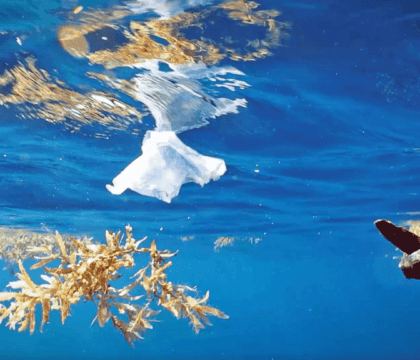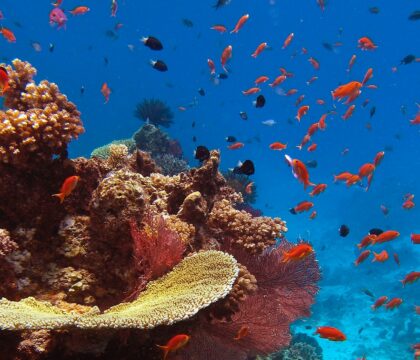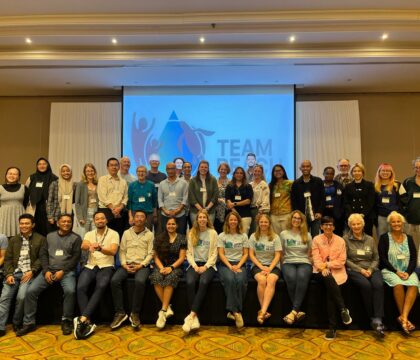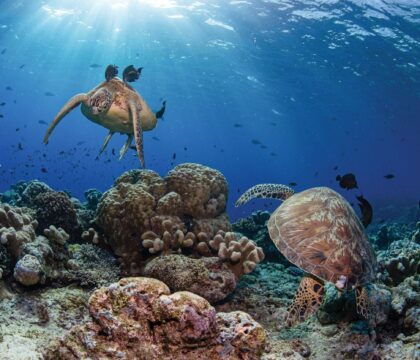July 24, 2023 • Ocean Facts, Resources
Sea turtles are incredible animals that inspire affection and curiosity. But because they live most of their lives at sea, they are shrouded in mystery. Scientists have spent decades trying to unravel the many mysteries of sea turtles’ lives through research and observation which has luckily revealed intriguing facts about sea turtles.
Here are 11 of the most interesting facts about sea turtles to help demystify these beloved creatures!
1. Sea Turtles Outlived the Dinosaurs

A leatherback turtle returns to sea after nesting. © Ben J Hicks
Sea turtles are often compared to dinosaurs due to their scaly, reptilian appearance. In fact, sea turtles were around at the same time as dinosaurs! That’s right, sea turtles as we know them today evolved 110 million years ago and have changed very little in the years since. This means that they not only coexisted with dinosaurs for around 45 million years, but they also outlived them, surviving the mass extinction event that took place approximately 65 million years ago.
2. You Can Tell Sea Turtles Apart by Their Shells and Scales

Photos of sea turtles’ faces can be used to identify them individually solely based on the scale pattern. © Wayne Sentman
You can tell sea turtle species apart by the color, shape, and pattern of their shells (called scutes) and the pattern of the scales on their faces. Each species has unique “scute patterns” on their shells and faces that offer the only surefire way to distinguish between species.
And not only can you tell sea turtle species apart by these features, you can also tell individual turtles apart! The scale pattern on a turtle’s face is as unique as a fingerprint, and scientists are now using those unique patterns to identify and keep track of individual sea turtles.
3. Sand Temperature Determines the Sex of Sea Turtles

When hatchlings emerge from a nest, it’s impossible to tell their sex but we can estimate the ratio of males and females based on the temperature during incubation.
When a female turtle lays her eggs deep in the sand, the eggs are fertilized, but the sex of each embryo has yet to be decided. The temperature of the sand during the middle portion of the 45-65 days that the sea turtle eggs incubate will determine whether the egg hatches a boy or a girl turtle.
Generally, eggs that incubate at temperatures above 31ºC (87.8ºF) will produce 100% female sea turtles, whereas temperatures below 27.5º (81.5ºF) result in 100% male turtles. Nests that incubate between these temperatures will hatch a mix of male and female turtle babies, with 29ºC (84.2ºF) producing a 50% male:female sex ratio. As climate change causes temperatures at nesting beaches to rise, the issue of an unbalanced sex ratio has become a topic of concern.
4. Only 1 in 1,000 Turtles Will Make it to Adulthood

Once in the water, a hatchling turtle will have to survive many challenges to survive to adulthood. © Ben J. Hicks / benjhicks.com
Based on population calculations, on average, only 1 in every 1,000 sea turtle eggs will become an adult turtle. As adults, sea turtles face very few predators – in fact, their biggest threats are from people. But as hatchlings and juveniles, sea turtles are very vulnerable to predators.
Starting as soon as they leave the nest, hatchlings become prey to almost any animal that can fit a baby turtle in its mouth. During their short journey from the nest to the ocean, hatchlings must avoid numerous predators, including birds like hawks, frigatebirds, and gulls, crabs, and domestic animals like dogs. Once in the water, baby sea turtles are targeted by large fish and sharks until they grow too big to eat. Learn more about the sea turtle life cycle.
5. Sea Turtles Live a Long Time

A large male loggerhead turtle swims past a diver in Belize.
How long do sea turtles live? This is a surprisingly difficult question to answer, although scientists have been working on it for decades. We do know that sea turtles have a long lifespan, with some individuals living between 50 and 70 years in the wild, and possibly longer.
The oldest known sea turtle is one named Myrtle, a green turtle that has lived at the New England Aquarium since 1970 and is estimated to be around 90 years old!
6. There are Seven Species of Sea Turtles
That’s right, there are seven different species of sea turtles, all with unique physical characteristics, habitats, diets, and life histories! The species are generally broken up into two categories: hard shell and soft shell.
Six of the seven species are hard shells and belong to the Cheloniidae family and include green turtles, loggerheads, hawksbills, olive ridleys, Kemp’s ridleys, and flatbacks. The one and only soft-shelled species, the sole member of the Dermochelyidae family, is the leatherback turtle. Learn more about the sea turtle species here!
7. Turtles Use Earth’s Magnetic Field to Navigate

A hawksbill turtle rests on the reef in Raja Ampat, Indonesia. © John McCormick
Sea turtles make incredible migrations, with some species crossing entire ocean basins. So how do sea turtles navigate these long distances? Research shows that sea turtles can sense the strength and direction of the sun and Earth’s magnetic field, which gives them a sense of where they are in the world.
This internal magnetic map, combined with cues from the environment around them, allows sea turtles to find their way to their nesting beaches and feeding grounds, sometimes thousands of miles apart. Learn more about how sea turtles navigate.
8. It Takes Up to 30 Years For a Turtle to Become an Adult

These mating black (green) turtles are all at least 25 years old – the age that they reach sexual maturity. © Tui de Roy / Roving Tortoise Photos
Sea turtles take an extremely long time to grow from a hatchling into a reproductive adult. Depending on the species, a female sea turtle can take between 10 and 30+ years to lay her first eggs. Leatherback turtles are the fastest maturing species, and can reach sexual maturity as soon as 12 years after hatching. The hardshell species, such as green turtles, take closer to 20-30 years to reach sexual maturity.
9. Sea Turtles Make Giant Migrations
Two green turtles return to sea with satellite tags attached to their shells. Sea turtles make vast migrations throughout the ocean. © Brian J. Hutchinson
Every few years, adult sea turtles migrate between their feeding grounds and their nesting beaches and offshore mating habitats. Sometimes sea turtles swim across entire oceans for these migrations, using Earth’s magnetic field to navigate.
The most impressive sea turtle migrations are those made by leatherback turtles from nesting beaches in West Papua, Indonesia that travel across the entire Pacific Ocean to reach feeding areas off of the West Coast of the United States. One of these leatherbacks holds the record for the longest migration made by any marine vertebrate, swimming 12,774 miles (20,558 km) from Indonesia to Oregon, USA!
10. Sea Turtles Return to Nest at the Same Beaches Where They Hatched

When sea turtles hatch, they learn their location using Earth’s geomagnetic field. Decades later they will return to the same area to mate or nest, a process known as natal homing. © Brian J. Hutchinson
When sea turtles hatch from their nests, it’s thought that they learn their location using the Earth’s magnetic field, a phenomenon known as geomagnetic imprinting. Even after as many as 30 years, when a sea turtle hatchling becomes a mature adult, it remembers the location from which it was born, like an address. The turtle will then be able to navigate thousands of miles back to the same beach (or nearby beach) to lay its eggs, an extraordinary process called natal homing.
11. All Sea Turtle Species are Threatened with Extinction

A sea turtle mistakes a plastic bag for food. © Ben J. Hicks / benjhicks.com
All seven sea turtle species are threatened with extinction to varying degrees. Sea turtles face numerous threats, most caused by humans, that have caused their populations to decline worldwide. The five main threats to turtles are fisheries bycatch, pollution (including plastics), climate change, coastal development, and direct take of eggs and meat. Learn more about threats to sea turtles and how you can help sea turtles.
These facts about sea turtles only scratch the surface when it comes to the animals’ intriguing anatomy, life histories, and ecology. But as more technology and research comes out about sea turtles we will continue to learn more about them and their environments. For more in depth information about sea turtles, check out our in depth guide to everything you need to know about sea turtles.
Learn more about our global sea turtle conservation programs.




